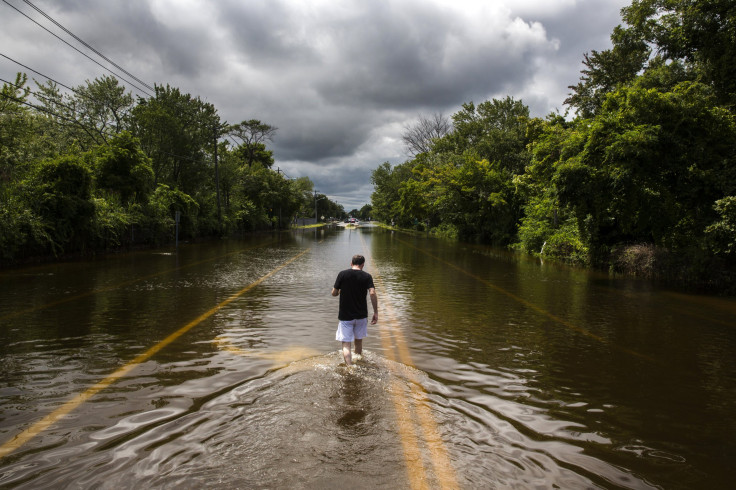Oklahoma, Texas Flash Floods Force Evacuations After Record Rainfall [PHOTOS]

Flash floods swamping Oklahoma and Texas this weekend claimed their first fatality early Sunday, a firefighter who perished while attempting to carry out a rescue in Claremore, Oklahoma, CNN reported. Meanwhile, the National Weather Service has called for the evacuation of thousands of buildings across both states, including the Hays County Jail in San Marcos, Texas.
Heavy rainfall broke Oklahoma City’s all-time monthly record Saturday, when it reached 17.61 inches in May, with more on the way, CNN said.
More than 60,000 people did not have power in Oklahoma and Texas Saturday night, NBC News reported. And more than 1,000 homes had been evacuated -- in some cases by police officers who told residents they had to leave immediately as they walking door-to-door. Roads such as Interstate 35 were shut down because they were unusable.
“This is a lot more serious than we anticipated,” Mayor Glenn Barham told reporters in Wichita Falls, Texas.
HI. THERES A FLOOD AT MY APARTMENT. A REAL LIFE FLOOD. LIKE CARS ARE STUCK AND WHATNOT. pic.twitter.com/nPhuCEGvRw
- Kadijah (@kadijahw) May 24, 2015From a viewer. Highway 16 in Beggs. Yeesh. #OKFlood #OkWx pic.twitter.com/RpX1e6EPcu
— Ben Walnick (@BenWalnick) May 24, 2015Authorities declared Caldwell County in Texas to be in a state of disaster, while more than 40 counties in Oklahoma were declared to be in a state of emergency.
Caldwell County’s proximity to the dangerously high San Marcos River worried local officials. “This is a historic flood,” the county emergency management coordinator, Martin Ritchey, told NBC News. “The record before was 34 feet; now it is over 39 feet. That wall of water will be coming into our county.”
Residents in San Marcos dealing with severe flooding this morning #Kxan pic.twitter.com/EHs6a8cJpl
- Paul Shelton (@PhotogPaul) May 24, 2015My thoughts & prayers w/ #Friends @RealAleBrewing & everyone in #Blanco #TX with #River being 40ft. Over #flood stage pic.twitter.com/LDf8B9lRPY
— Michael E (@MichaelAusTx) May 24, 2015Making a bad situation worse, AccuWeather.com reported that “the end of this persistently wet pattern is nowhere in sight.” More flash flooding, hail, strong winds and tornadoes are likely in the next week, according to the Weather Prediction Center’s seven-day forecast. Areas not only in Oklahoma and Texas but also in Arkansas, Kansas, Louisiana and Missouri could be affected.
Looking North from the Falls in Wichita Falls Thursday AM. Wichita River out of its banks. #Flood @timesrecordnews pic.twitter.com/b5k2aD78iJ
- Torin Halsey (@photosbytorin) May 21, 2015Southbound 35 is currently submerged in flood waters in San Marcos. @KXAN_News pic.twitter.com/HBta9MQH25
— Paul Shelton (@PhotogPaul) May 24, 2015If you’re caught in a flash flood, the National Weather Service recommends you move to higher ground immediately, obey evacuation orders and avoid moving waters. Drivers should “turn around, don’t drown” when facing with flooded roads. Find more information on flood safety here.
© Copyright IBTimes 2024. All rights reserved.












